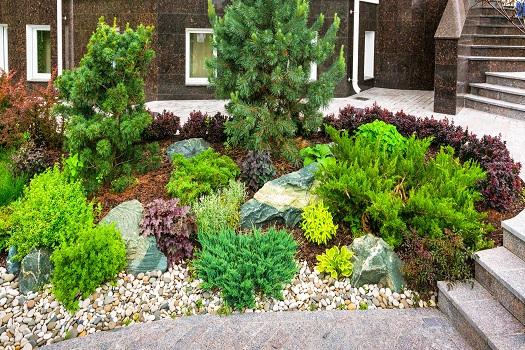White rocks are a popular choice for landscaping due to their clean, bright appearance. However, over time white rocks can become stained and take on a yellowish tinge.
In this article, we’ll explore the common causes of white landscaping rocks turning yellow and provide tips on how to restore their original color.
What Causes White Rocks to Turn Yellow?
There are a few key reasons white landscaping rocks may start to look yellow:
Iron Oxidation
One of the most common causes of yellowing is iron oxidation. Many types of natural rocks contain iron mineral deposits. When the iron is exposed to water and air, it oxidizes and forms a yellowish rust.
This is accelerated if rocks are wet frequently from rain, sprinklers or being placed around pools or fountains. Acidic conditions also encourage iron oxidation.
Soil Runoff
As rain or irrigation water flows over soil, it picks up dirt, clay and minerals. These materials can stain rocks over time as the runoff accumulates. Soil stains often appear as yellowish discoloration.
Organic Material
Organic matter like leaves, grass clippings and tree sap can leave yellowish-brown stains as they decompose on the rock surface. Driftwood, mulch or compost touching rocks may also cause discoloration.
Pollution and Contaminants
Environmental pollutants like vehicle exhaust can create a yellowish grimy film on rocks. Contamination from fertilizers, pesticides and road salts may also contribute to yellowing over an extended period.
Weathering and Wear
Exposure to sunlight, wind, rain and temperature extremes slowly erodes and wears down rocks over years. This weathering reveals underlying discoloration in the stone.
Improper Cleaning
Harsh cleaners, dirty tools and wax buildup from products can stain rocks yellow. Pressure washing too aggressively can also etch rocks, making them appear yellow.
How to Clean Yellowed Landscape Rocks
If your bright white rocks have dulled to a yellowish hue, try these cleaning methods:
Remove Debris
Pick up any leaves, dirt or other debris resting on top of the rocks. This prevents stains from setting further if wet debris starts to decompose.
Apply Dish Soap
Mix a few drops of mild dish soap into a bucket of warm water. Use a soft brush to gently scrub stained rocks. Let the soap solution sit briefly before rinsing. Avoid using harsh detergents.
Use Baking Soda
Make a paste with baking soda and water. Apply the paste to stained rocks and let sit for 10-15 minutes before scrubbing and rinsing clean. The baking soda will help lift some types of yellow stains.
Try White Vinegar
Spray full strength white vinegar onto yellowed rocks. Let the vinegar sit for 5-10 minutes before scrubbing with a stiff brush and rinsing thoroughly with water. Repeat as needed for stubborn stains.
Use Hydrogen Peroxide
Hydrogen peroxide can help remove yellowish organic stains and discoloration. Spray it onto dry rocks, let bubble for 10 minutes and then rinse well. Be sure to wear gloves when handling hydrogen peroxide.
Make a Poultice
For iron stained rocks, make a poultice using hydrogen peroxide, baking soda and powdered dishwasher detergent. Apply to stains, wrap in plastic and let sit overnight before rinsing. A commercially made iron stain remover product can also be used according to label directions.
Pressure Wash Properly
For heavier soiled rocks, use a pressure washer at low pressure and wide nozzle angle. Keep the nozzle constantly moving to avoid etching or damaging rocks. Pressure washers can scrape off some types of yellowing.
Buff With Baking Soda
Make a paste from baking soda and lemon juice. Gently rub the paste onto stained rocks using a soft cloth. Rinse thoroughly. The baking soda works like a scouring powder to buff away some discoloration.
Tips for Preventing White Rocks From Yellowing
To keep white landscape rocks looking freshly bright for as long as possible:
- Place rocks away from irrigation spray to minimize wetness
- Slope ground so water drains away from rocks
- Apply a sealer to protect against stains
- Cover rocks with tarps during fertilizer/pesticide applications
- Remove organic debris like leaves before it decomposes
- Add a layer of gravel under rocks to prevent direct soil contact
- Use drip irrigation or soaker hoses rather than sprinklers
- Control runoff from gutters, slopes and impermeable surfaces
- Clean rocks periodically using mild cleaners and brushes
- Adjust watering schedules to allow rocks to fully dry between waterings
Keeping your landscape rocks clean will extend their appeal and minimize how often you need to use intensive cleaning methods to remove yellow discoloration. With proper care, it’s possible to enjoy brightly white rocks for many years before heavy discoloration sets in.

